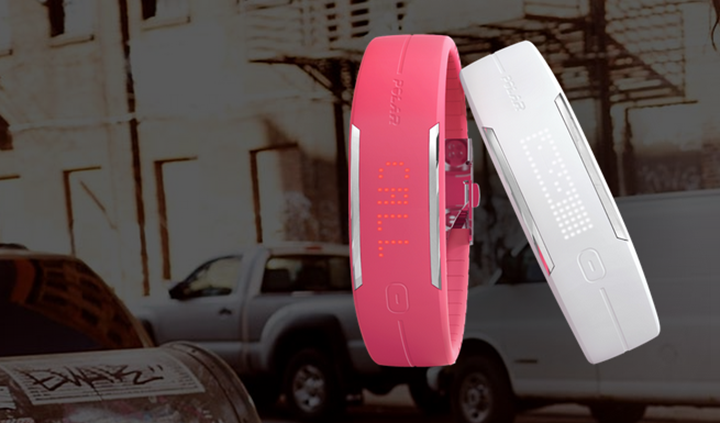Epson Runsense SF-810 GPS watch with optical HR: In-Depth Review
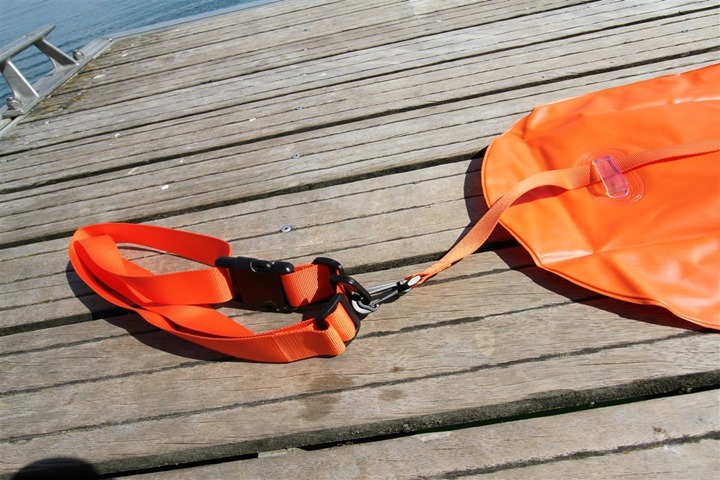
Over the last 8-9 months, Epson has introduced a number of fitness wearables into the market. While that might seem odd for a company known primarily for printers, one need only remember that Epson is part of the Seiko Epson group – of famed watch lineage. So in that light, making a running watch makes a bit more sense.
As part of their newfound fitness foray, they’ve introduced a flotilla of products (over half a dozen fitness units nearly at once). By most estimations, probably too many, but as they say in Texas: Go big or go home! For this review, I’m really only focusing on one of them, the Runsense SF-810 GPS running watch with optical HR. It’s their top-end watch at about $349/€299, and is the total of all the features in their lower running watch units. I talk more about the other models briefly later in the review.
This review is probably a bit different in that while I typically use a device for 2-6 weeks before a review, I’m going on close to 4 months now. So I’ve got a LOT of time and data with it, in all sorts of conditions. The good, bad, and the ugly.
To be clear, I’ve been using an SF-810 provided by Epson to test with. Like always, I’ll be shipping that back to them in the UK in the next little bit and going out and getting my own via regular retail channels. That’s just the way I roll.
Lastly, at the end of the day keep in mind I’m just like any other regular athlete out there. I write these reviews because I’m inherently a curious person with a technology background, and thus I try and be as complete as I can. But, if I’ve missed something or if you spot something that doesn’t quite jive – just let me know and I’ll be happy to get it all sorted out. Also, because the technology world constantly changes, I try and go back and update these reviews as new features and functionality are added – or if bugs are fixed. So – with that intro, let’s get into things.
Unboxing:
As I noted earlier, this review will focus on just the Runsense SF-810 GPS. But it should be clear that there’s a whole host of other units as part of the lineup. Within the Runsense watch lineup they basically just layer on features as you work your way up, for example adding the optical HR sensor support. Here’s a look at all of the current generation units.
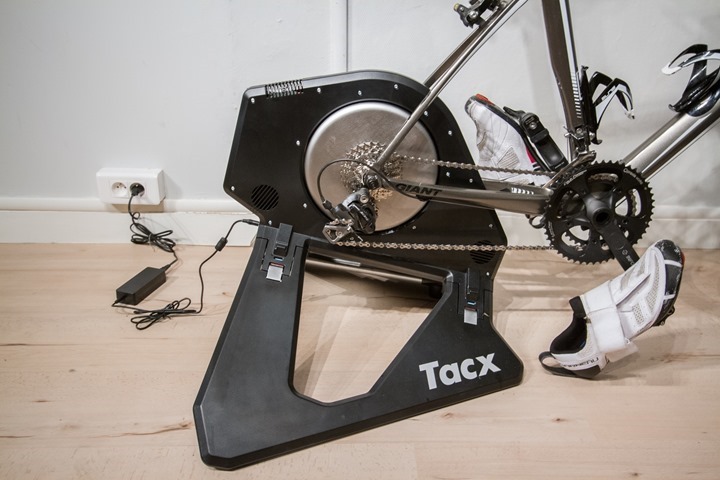
And, here’s the SF-810; what we’ll be focusing on. It comes in a few colors, though the sizes are identical.
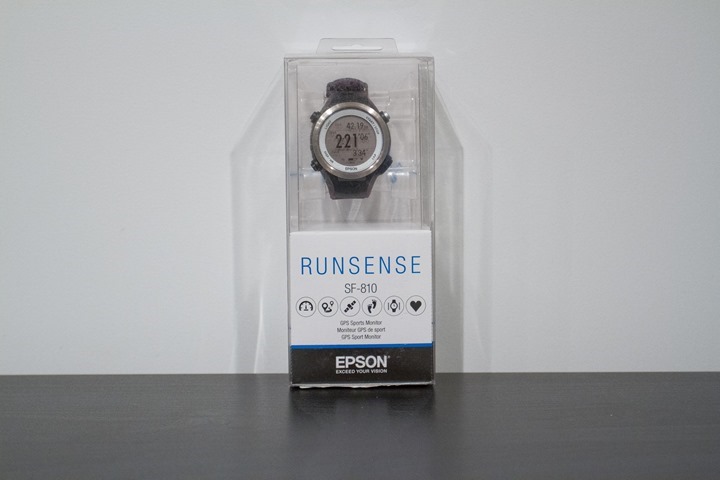
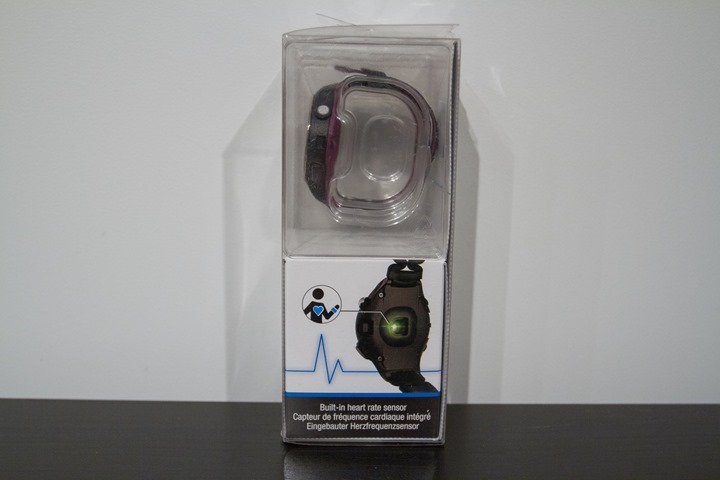
We’ll remove the inside compartments out of the plastic shell:
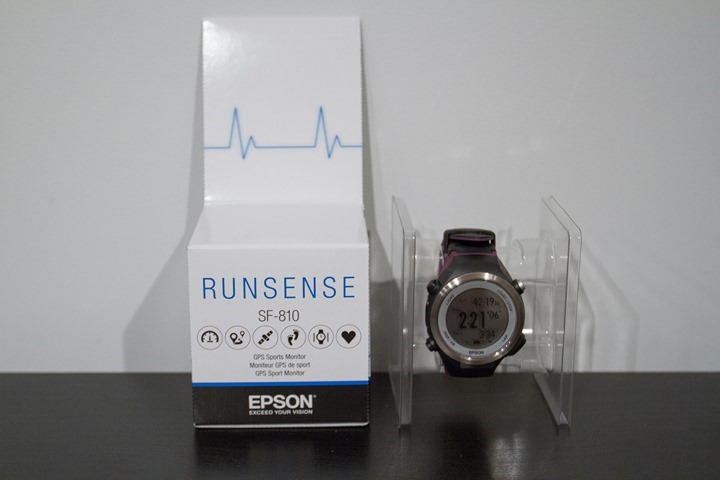
Which once you unpack it all, it gives you the charger, the watch, and a massive stack of papers:
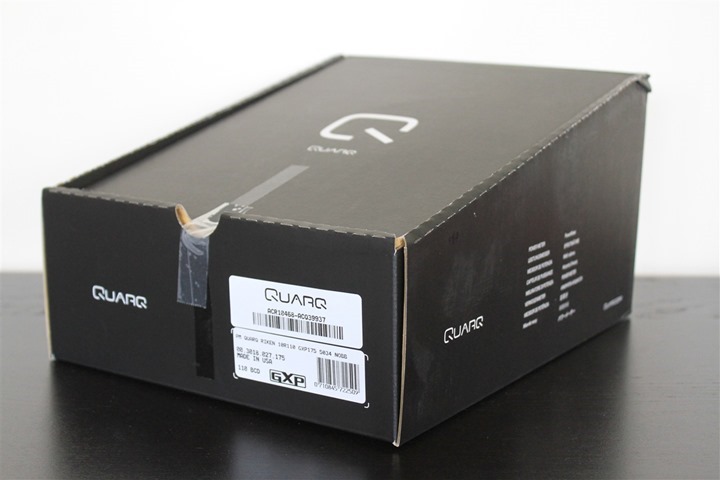
The papers are the quick start guides in a handful of languages. They aren’t so much quick, as more thorough guides. But that’s OK. Given the watch user interface, you’ll definitely not want to toss these guides (though you can always download the PDF guide later online).
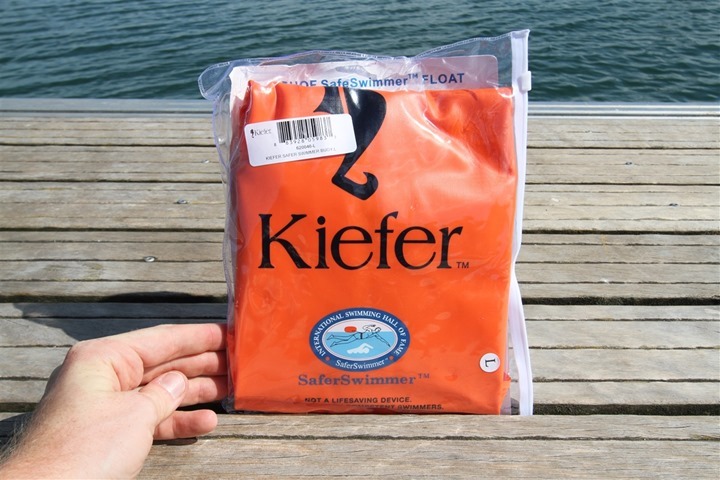
Next is the charging clip. It’s kinda-sorta massive. But, I’ve never had an issue with it not charging or the unit falling out. It’s basically bombproof.
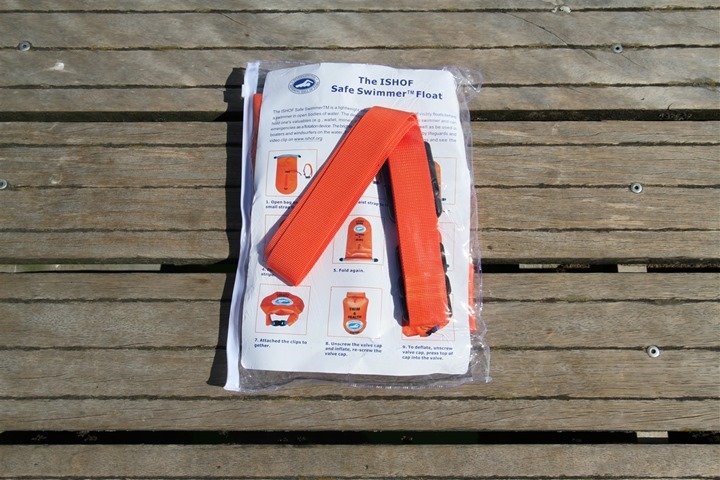
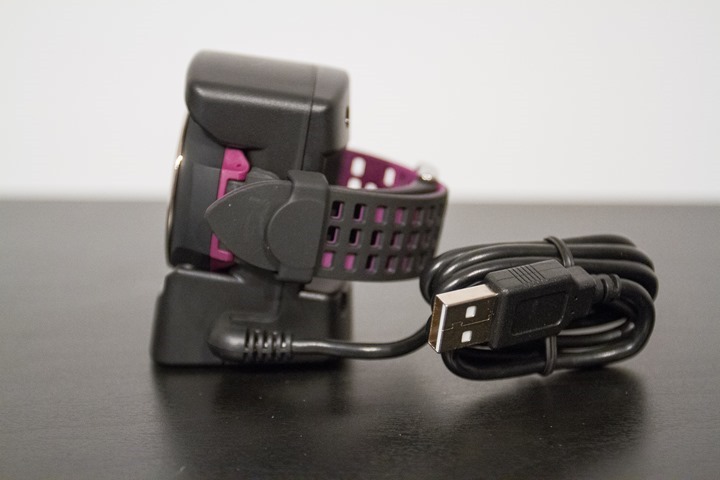
Finally, we have the unit itself. Fear not, you’ll see a lot of it over the course of the review. Actually, I had two units – a purple one and a black/white one. I used the black one for almost everything.
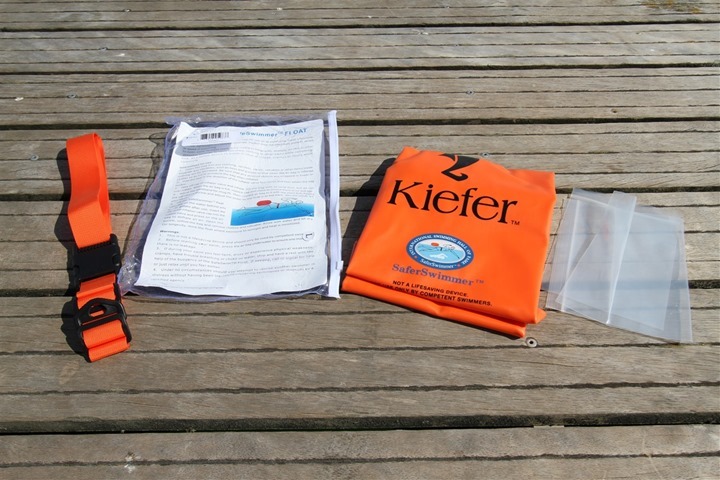
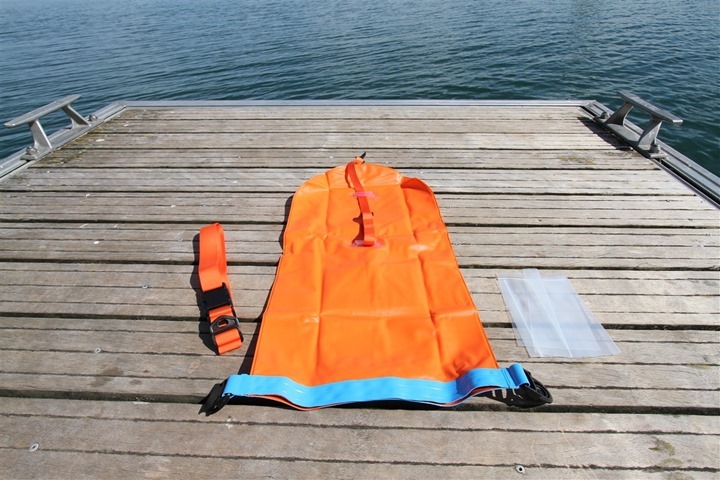
With that, let’s move onto to how it stacks up against other units out there size-wise.
Size & Weight Comparisons:
To begin, we’ll look at the size of the watch compared to others, mostly in the higher end category. Though, watches don’t tend to get any smaller than the smallest ones shown here.
From left to right we have:
Garmin FR910XT, FR920XT, Garmin Fenix3, Fenix2, Suunto Ambit3, Polar V800, Garmin FR620, Epson SF-810, Fitbit Surge.
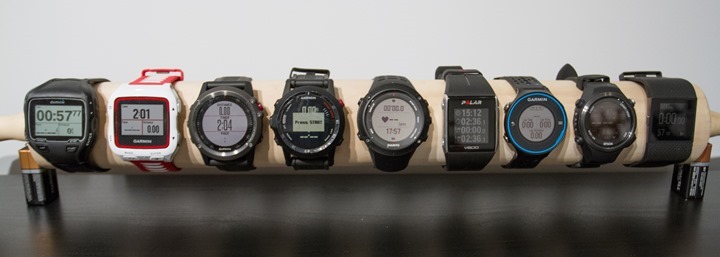
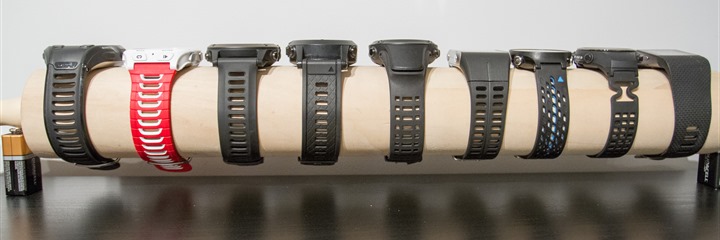
Looking at the height, you’ll see that it’s aligned to both the Fitbit Surge and a touch bit higher than the FR620, all running focused watches. As you’ve probably noted, size is not an issue here, it’s nice and small.
Next, looking at weight, the Epson SF-810 comes in at 52g:
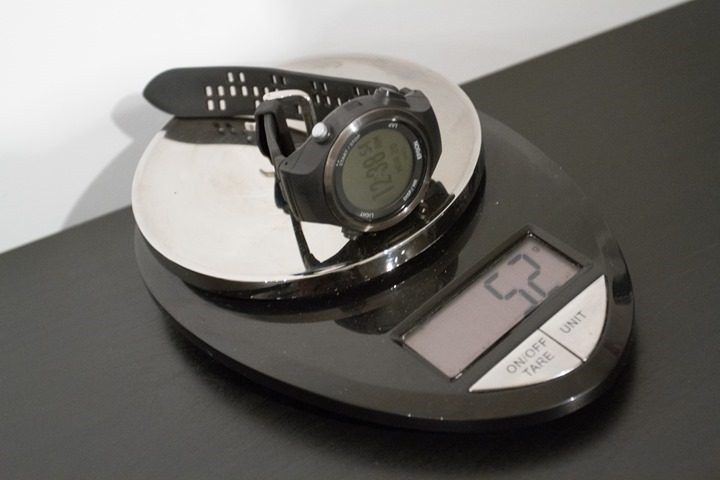
Meanwhile the optical-sensor capable Fitbit Surge at 51g:
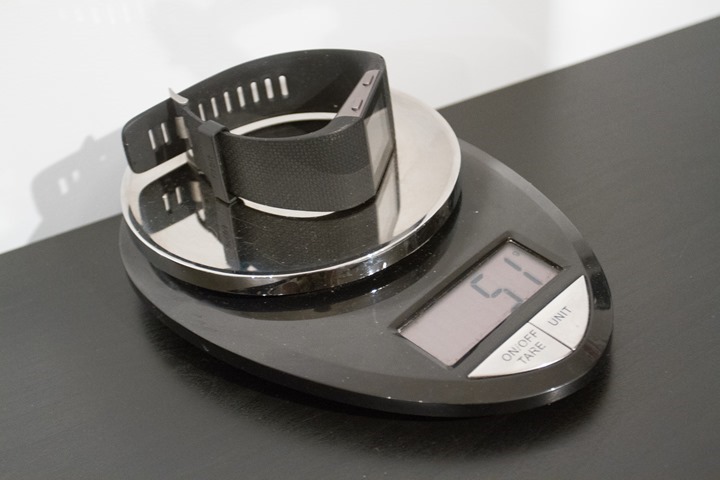
The TomTom Cardio unit at 63g (also optical sensor capable):
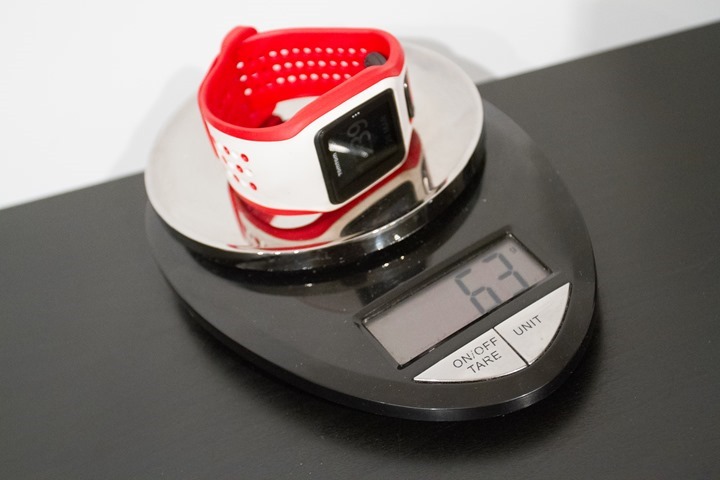
And finally, the Garmin FR620 at 44g. It does not have an optical HR sensor in it:
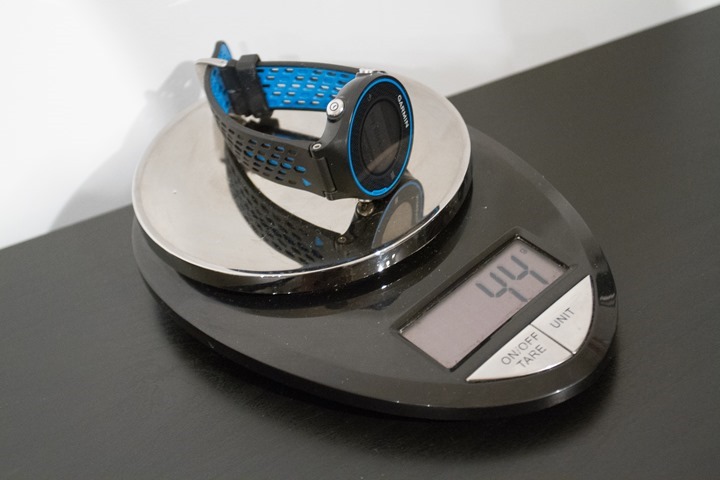
As you can see, weight wise it’s right in the mix, with no substantial amount of weight to its name. Finally, to see how it looks on my wrist, here’s a few more shots:
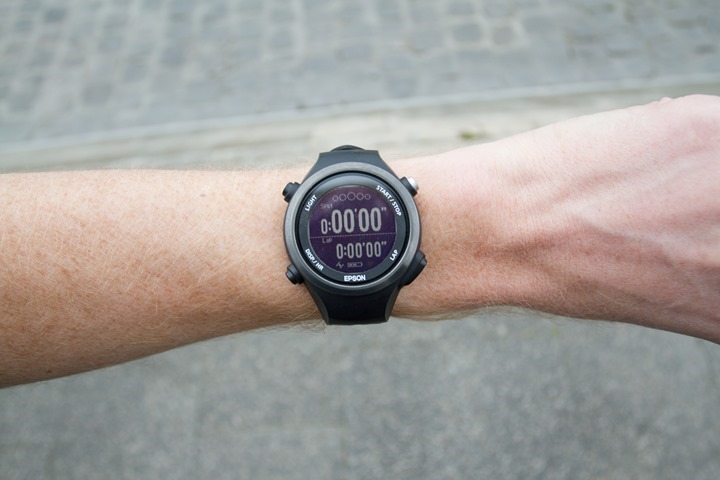
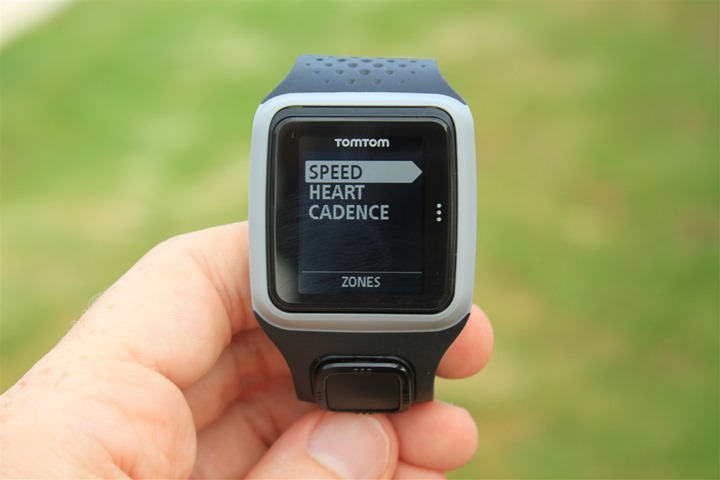
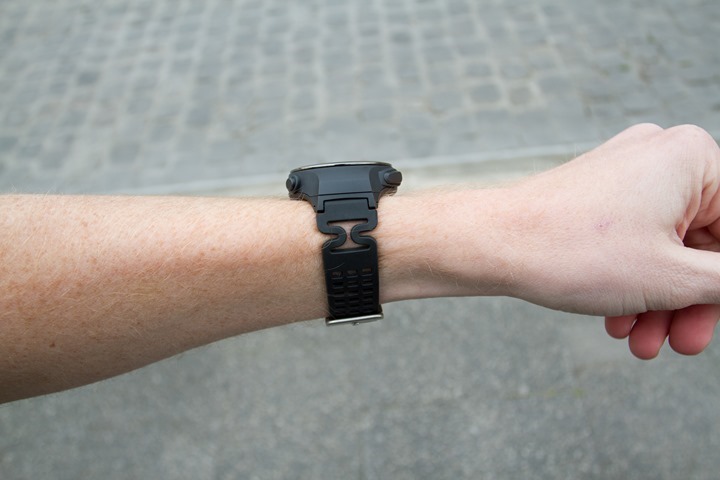
But don’t worry, you’ll see plenty of shots of the SF-810 throughout the review. So let’s get onto running.
Running:
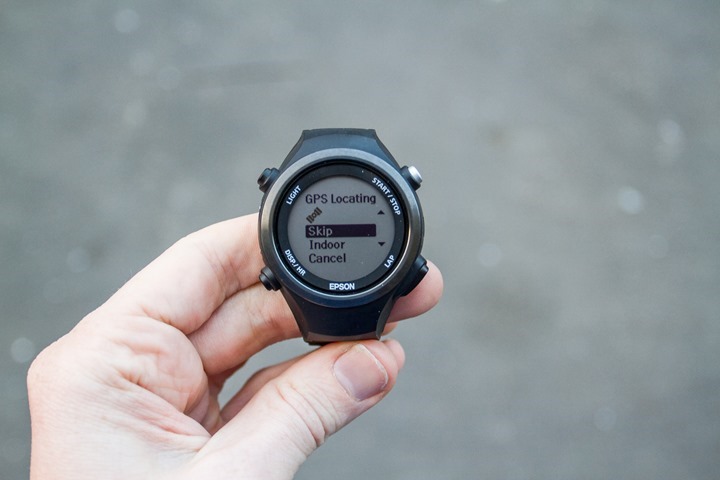
Of all the GPS watches out there, the Epson 810 is about as simple as it gets when it comes to starting a run. There’s no complex menus to navigate or decisions to make.
To begin, you’ll simply press the start button. This will trigger the unit to start searching for GPS satellites. It’ll show your progress with four little satellite icons:
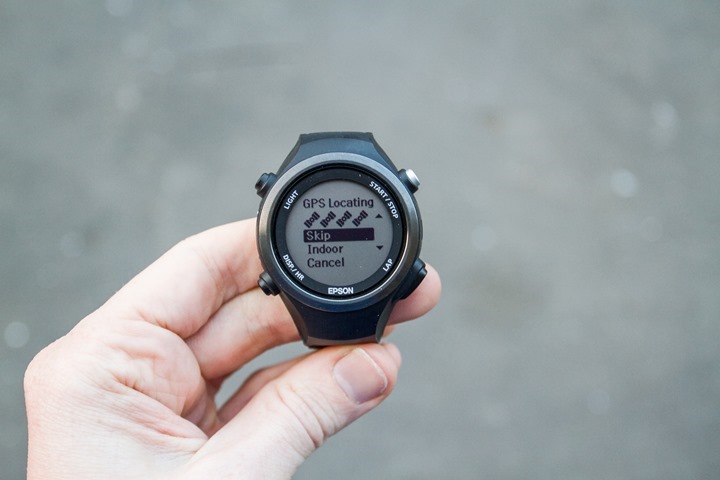
Now in my experience this process isn’t quite as fast as most of the competition. It’s not unbearable, but it’s not McSpeedy either. You can pre-cache GPS satellites by cracking open your mobile phone app and downloading the GPS pre-cache data. This will speed up satellite acquisition.
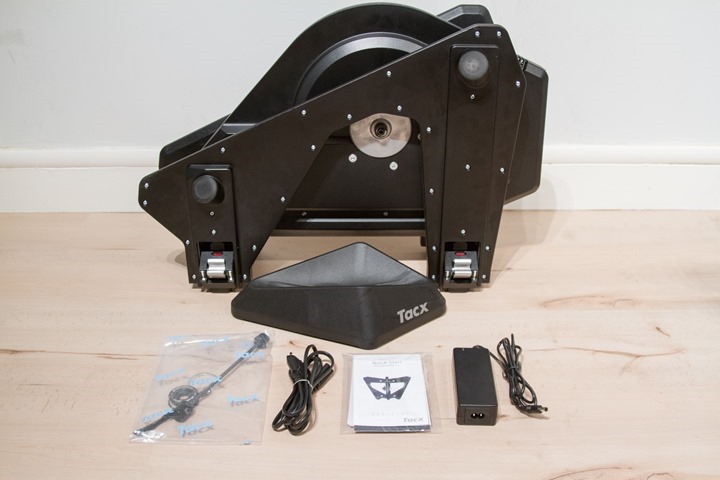
Except the problem here is that this data only lasts two hours. And quite frankly by time you open up the app and navigate to these menus and sync everything, you might has well have just stood outside for that time and found satellites. Plus, every other watch on the market satellite-caches for a minimum of 7 days, if not 14 days.
Once it has found satellites, it’ll go ahead and chirp that it’s ready and will be on the display ready for you to press ‘Start’ again.
However, before you do that you’ll want to double-check that it has found your pulse. In my experience this really seems to vary quite a bit. Sometimes it’ll find it immediately, and other times it takes a minute or so. It seems to be aligned to how chilly it is outside. It’ll chirp when it’s ready though. You’ll then see it listed on the screen too.
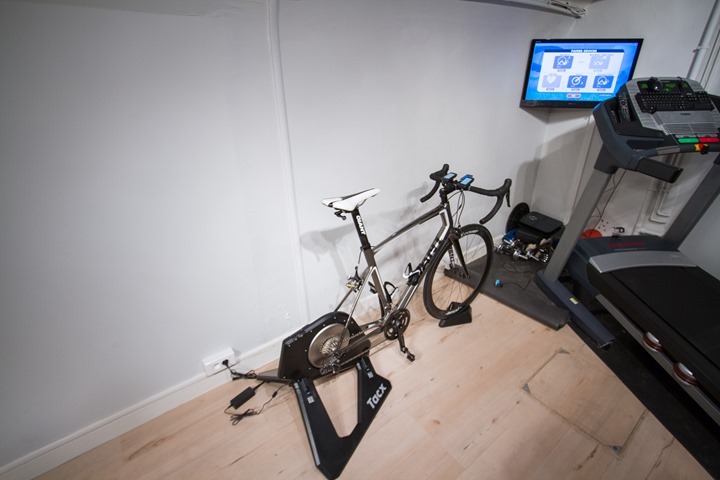
Once you press start, it’ll start recording. This is also the appropriate time for you to start running. By default the unit will have auto pause enabled, but you can turn that off from the mobile app should you wish to. Auto pause essentially pauses the unit when you stop running. In my experience, it works fairly well here.
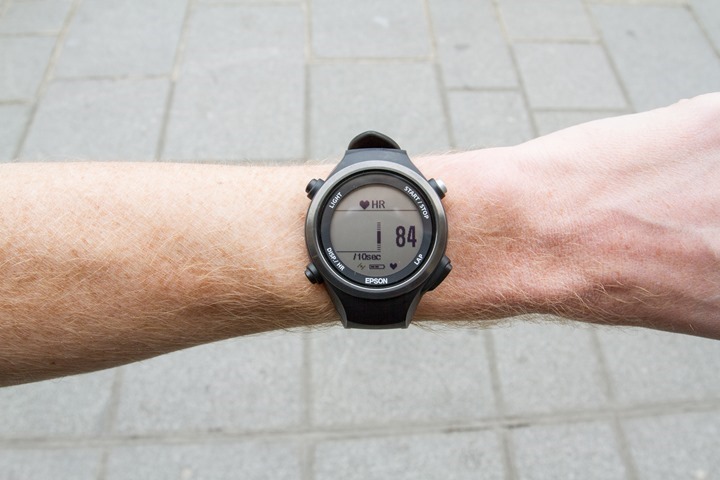
Now that you’ve started running, you’ll see your various data pages shown on the unit. The SF-810 allows you to configure 4 data pages, each with up to 3 data fields. These data fields and pages are configured via the mobile phone app or the watch itself:
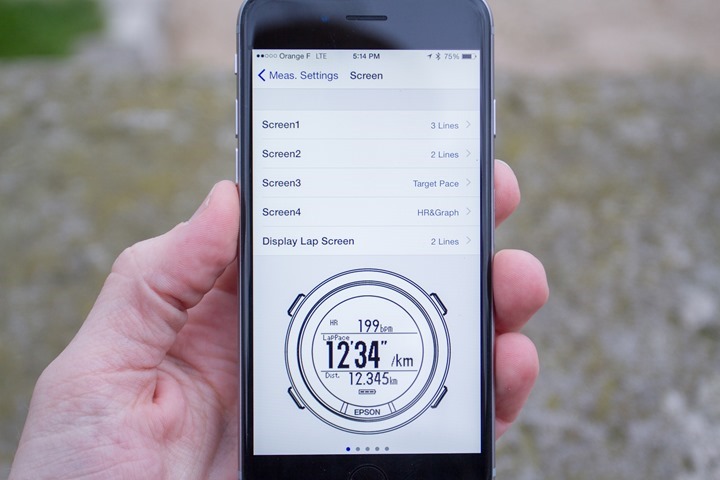
Here’s a small gallery of what the different pages look like. You can change the display while running by pressing the ‘DISP’ button, or by simply tapping the front of the screen.
When I look at aspects such as instant pace, I didn’t notice anything unusual – it paces quite nicely there. Which, actually segues into another topic area – pace targets. With this setting, you can configure a target pace, but then also configure a target range. This can be configured via either the desktop or phone apps.
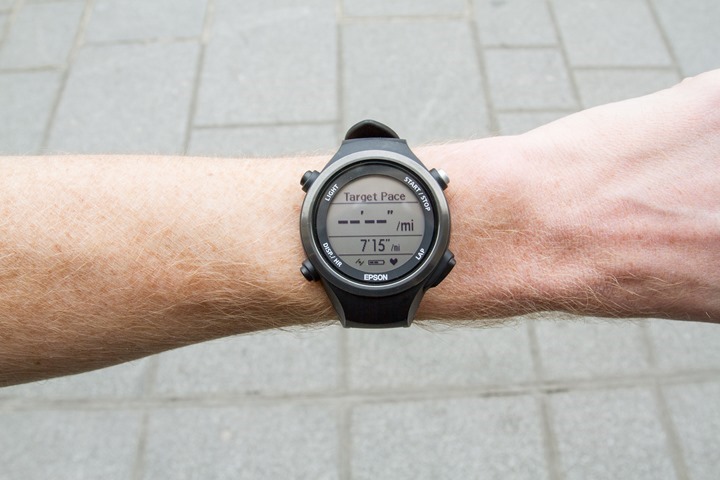
This is actually pretty unique in the GPS watch realm. Most units only allow you to configure a set target pace, and then get all upset at you when you stray even a little bit. Some allow you to set an upper/lower threshold, effectively forming a range. But I like Epson’s implementation the best – which allows you to simply configure a target pace value, and then a +/- range beyond that. Why other companies haven’t done this yet is beyond me.
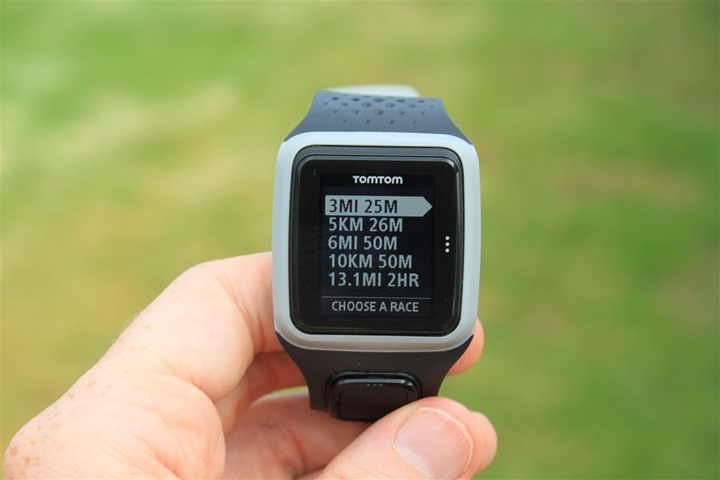
In the case below, in order to get a crisp picture I’m just walking. But I had it set for 7:15/mile +/- 30s. You can see the range then of 6:45-7:45/mile, with me currently at a whopping 11:25/mile.
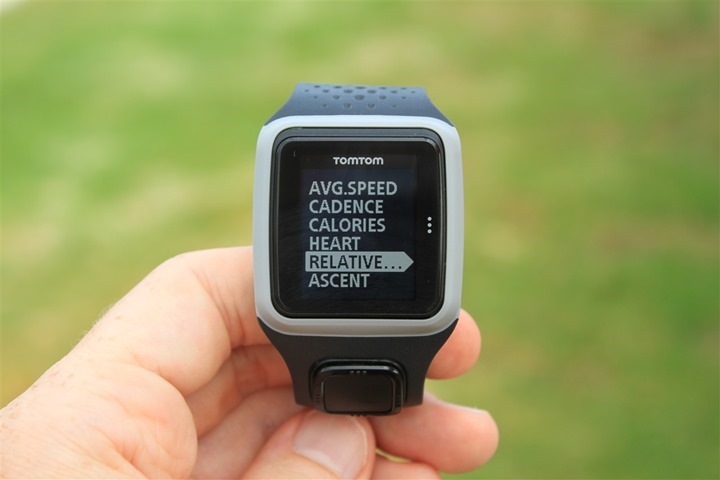
Next, like most GPS watches the unit includes an Auto Lap capability. You probably wouldn’t know it though, as it’s abbreviated “AT Lap”. For some reason Epson has decided to abbreviate Automatic as ‘AT’, as opposed to the much more logical use of ‘Auto’. In any event, you can configure this based on a variety of parameters such as distance or time. This is configurable on the phone, desktop, or the watch through the settings menu.
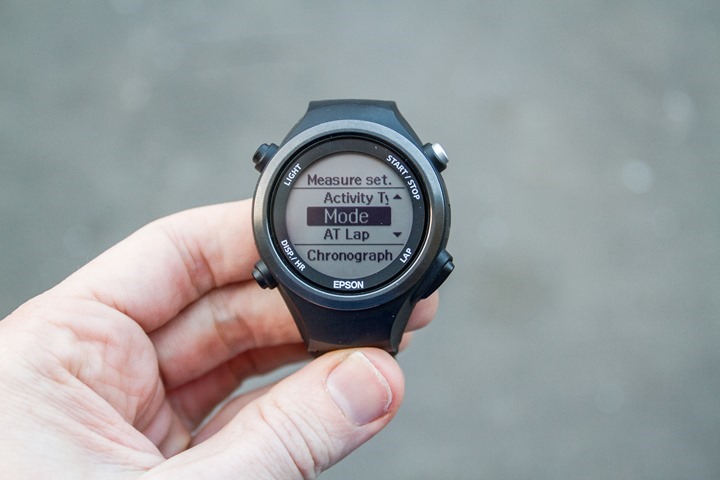
Last up we’ve got interval workouts. The unit supports a very basic interval mode that allows you to specify a work effort, rest effort, and the number of repetitions. It also supports specifying target HR zones per section. You can create these on desktop/phone/watch, and even edit existing ones on the watch too.
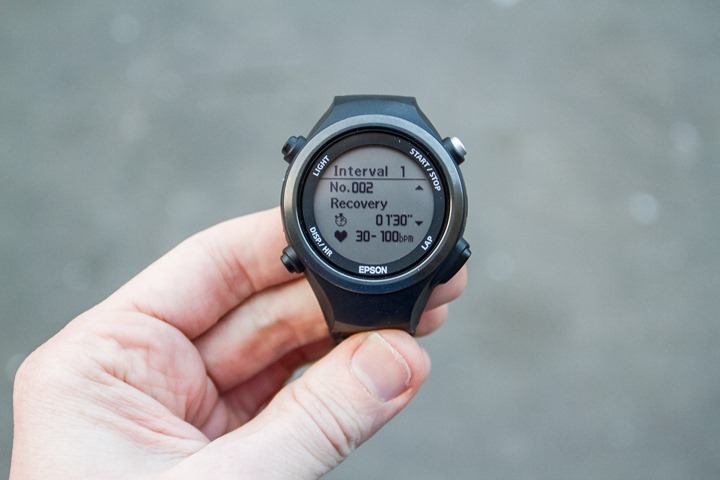
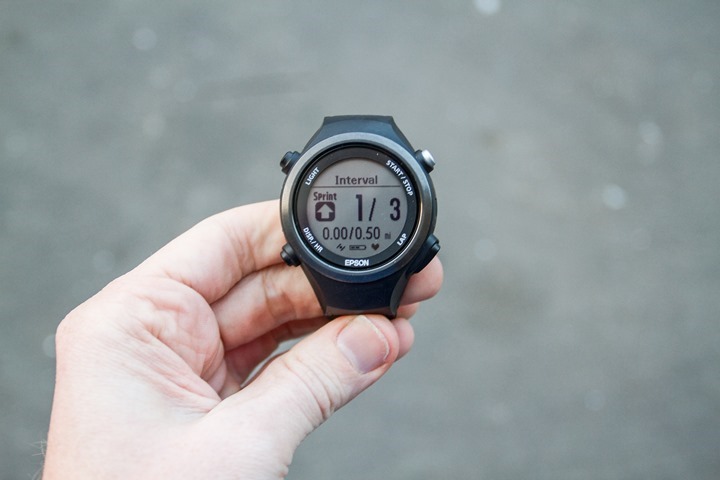
You can also save multiple interval workouts, so you can refer to them quickly down the road.
Once you’ve finished up the run you’ll simply press the Start/Stop button once to stop the run. At this point it’s just paused, so you can resume again if you wish. And, you can also scroll through any of the data pages too.
When ready to end the run for good, just hold down the stop button for a few seconds and it’ll save the data and note that it’s ready to upload.
You can also access your historical data from the history menu as well on the unit itself. In this case, they call it ‘Recall’. That’s one of the things you’ll see throughout the unit, is that the names aren’t terribly intuitive. It feels like they didn’t have a native English speaker help on the translations from Japanese, and kinda guessed at things. Terms like ‘History’ are used by every other watch out there.
Looking at other terms, ‘Chronograph’ hasn’t been used since the 1990’s. While these are easy to dismiss as language quirks, the reality is that the most successful watches out there appeal to wide swaths of people, including those that value easy to understand terms. And so much of the watch is using terminology that’s hard for even me to understand.
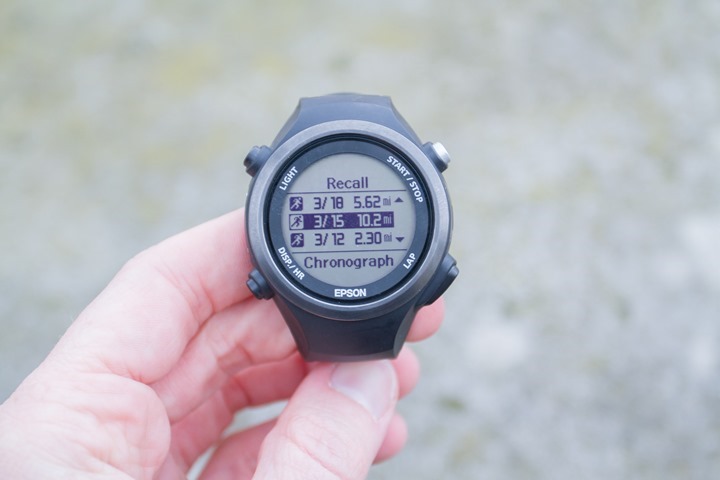
Finally note that in later sections I’ll talk about how to upload run data online via USB from your computer, or via the mobile phone app.
Treadmill Use:
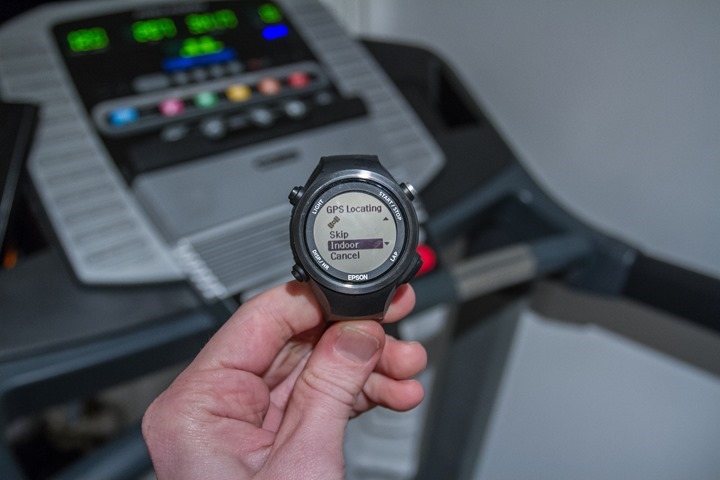
The SF-810 supports the ability to run indoors on a treadmill and calculate pace and distance using the internal accelerometer. This is common on most watches these days, and as is the case with most other watches as well – this method of pace calculation tends to be a bit…challenging.
To understand this I’ve done a number of treadmill runs, containing a variety of paces from an initial warm-up through higher paced intervals to simply walking as a cool-down. To compare paces, the treadmill actually records the exact pace for each and automatically uploads it. Additionally, I had another watch on with a footpod that was calibrated (albeit not quite perfect, it was pretty darn close). Virtually all of these resulted in similar behavior, so I’ll just exhibit one of them to show how it handles treadmill runs.
First up, here’s the pace file for the Epson (charted at 6.26mi):

And next, the pace file for a GPS watch that had the footpod calibrated to match the treadmill (6.52mi):

And finally, the actual treadmill export itself (6.54mi):

Now, if you look at the Epson…it pretty much looks bat-crap crazy. But what’s nuts here is that it sorta managed to get the distance in the ballpark – about .25mi off (6.26mi vs 6.54mi). That’s what I often see – cases where while the average works out, the exact pacing for each section is a mess.
So while I wouldn’t depend on it for pacing indoors on a treadmill, like most other GPS watches – the functionality is there. It’d be ideal if Epson would open up the ability to connect to Bluetooth Smart footpods, for better accuracy and logging.
Optical HR Accuracy:
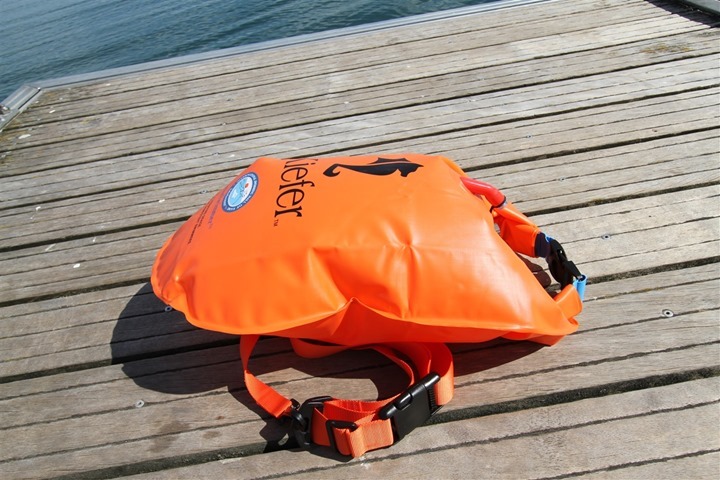
For many, the optical HR sensor included within the unit will be one of the biggest draws to the SF-810. The optical sensor is fully developed in-house within Epson (according to Epson), and isn’t a variant of an existing solution on the market such as Mio or Valencell. This had me worried at first, since most companies that attempt developing their own optical HR technology tend to fail there.
In the case of the SF-810, it thankfully doesn’t fall into that trap, and actually works quite well the vast majority of the time.
After you start the watch it’ll go about acquiring your pulse via the optical sensor. As a general rule remember that snug is better, you don’t want optical sensor bands loose. Outside light is also the evil enemy of optical HR sensors, so minimizing that is important too. In my case, it worked quite well just at the same position as most wrist-watches sit, about an inch or so up front your wrist bone.
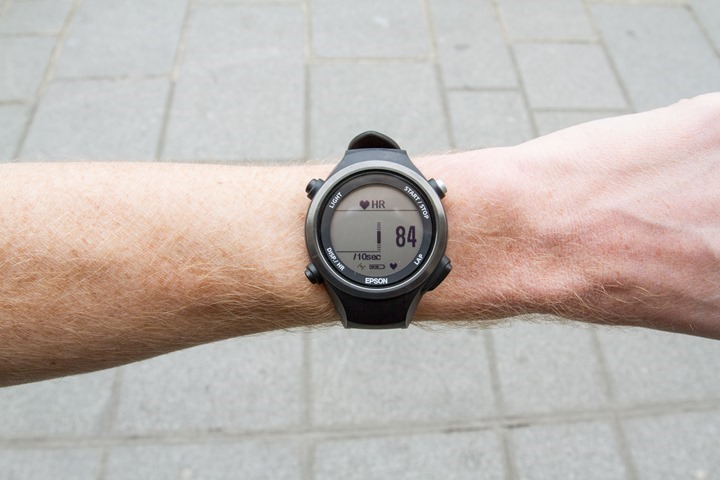
Typically it’ll find your HR within 30 seconds or so, though sometimes that can take a touch bit longer if it’s chilly outside. It’s another area that wrist-based optical sensors struggle a little bit on. Usually though once they lock onto the pulse they’re good to go (or, once you warm-up in really cold weather).
With all that background, let’s look at some data between a few runs. First up, a simple 40-minute run around the city. In this case it was a relatively constant heart rate for me in Z2. First up, the Epson file:

And then next the heart rate strap:

As you can see – the tracks align quite nicely (granted it’s sorta hard to see given how stable this run was). It’s a good first example though of where optical is often better in the first few minutes of a cold run, as the HR strap took a moment or two to lock on.
Next, we’ve got some intervals I did. This helps to show how well it tracks over variable paces and thus variable heart rate levels. It also shows how well it responds to change in heart rate. In this case, it was mile repeats in Dubai on a rather warm/humid night.
Here’s the Epson file:

And here’s the heart rate strap file – it’s virtually identical. In fact, I’d give the slight edge to the Epson here, as you notice in the first minute or so (the tick marks are miles on both screens), that it takes the HR strap a tiny bit longer to latch onto the HR.

Lastly, we’ve got another interval run I did, this one was a bunch of short 400m intervals, 12 of them actually. You can see them here:

Here’s how the Epson did on heart rate:

Eek, not good. In this case, it was a much colder night (in November), which probably matters. That compares with how the heart rate strap did:

If I look at all of my runs (I think about 30 or so now), it’s only this single run where I seemingly lost HR mid-way through. I’m not sure why. Perhaps it was the specific pace and the cadence that contributed with the cold (often when optical HR watches have tracking issues, they latch onto cadence).
One last optical HR sensor feature to briefly note is that you can check your pulse at any time by just tapping the lower left button, which will turn on the optical sensor:
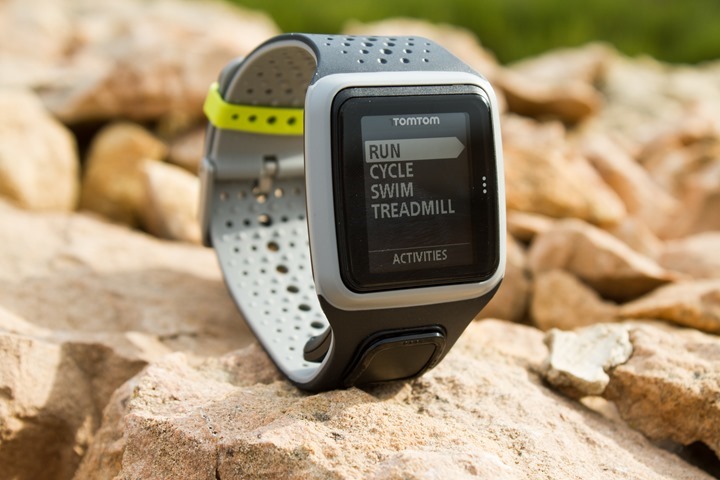
It won’t record this data, but just offers a quick way to double-check your heart rate.
Cycling Use:
The Runsense SF-810 isn’t really designed for cycling. After all, it does have the word ‘Run’ in the name of it. Still, you can create a cycling profile within the app and then assign to it speed-related values. The unit won’t connect though to any cycling sensors (i.e. cadence or power), so it’s really just limited to speed/distance data, along with HR data.
On the HR side I’ve gotten mixed results while riding. Indoors I generally seem to have no issues and it tracks well, but outside it’s not quite the same. Here’s an example of one ride:

The temperature on these rides was a bit cooler, so the watch was generally under my coat. Still, I wouldn’t have expected it to drop-out for nearly half the ride. A standard HR strap I was wearing on the same ride didn’t see any issues. And comparing the first half of the ride to that strap seems to result in a bit more variance than I would have expected from the Epson unit.
But again, tweaking the HR sensor to deal with road vibrations is something that some optical sensor companies have trouble with. Some companies are able to get past those issues, while others are unable.
Backlight, Daily Watch use:
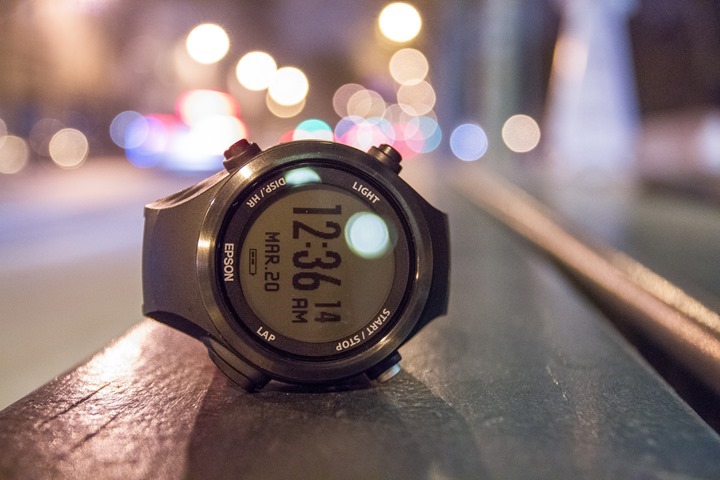
The unit acts as a day to day watch when not in a sport mode. The screen will automatically turn off to save battery, and then instant turn back on when movement is detected. You can have the screen be black text on white background (default), or invert it for white text on a black background. Additionally, you can adjust the contrast as well.
The unit will automatically set the time according to the GPS location, as with most GPS watches. You can display time in 12hr or 24hr format. And the same flexibility goes for date format, switching to and from Day.Month or Month.Day.
Unfortunately, there does not appear to be any way to set a daily alarm (i.e. to wake-up at 7AM).
On the backlight, it’s brilliantly bright, which can be seen below. The exact same photo is above, with the backlight turned off.
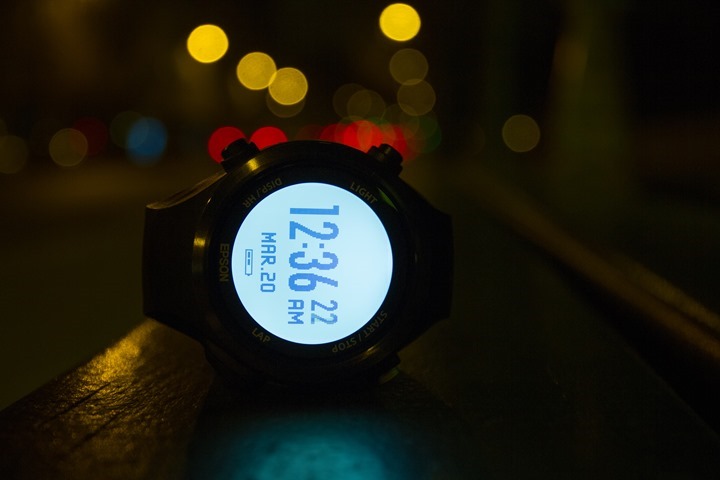
Finally, note that while it is a day to day watch, it does not contain any standard smart-watch functions like notification alerts or the like.
GPS Accuracy:
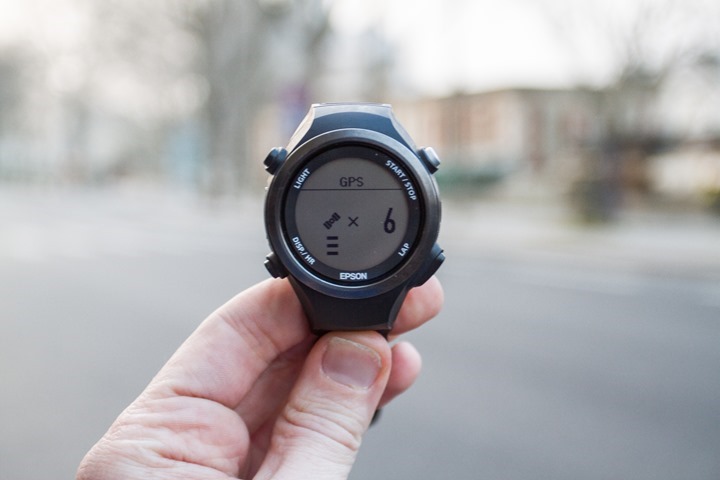
It’s probably fitting in some ways that the Epson SF-810 is the only running GPS watch I know of on the market that actually includes your distance to the degree shown of 5.354 miles. Yes, all the way to the thousandths of a place. When I first met with Epson last summer, they were rather proud of their GPS accuracy – almost taunting me to find issues with it. They were proud of their internally developed GPS chipset. In fact, they even sent me a little tiny card showing it and just how small it is. I’ve added a penny and a two-cent Euro piece for comparison:
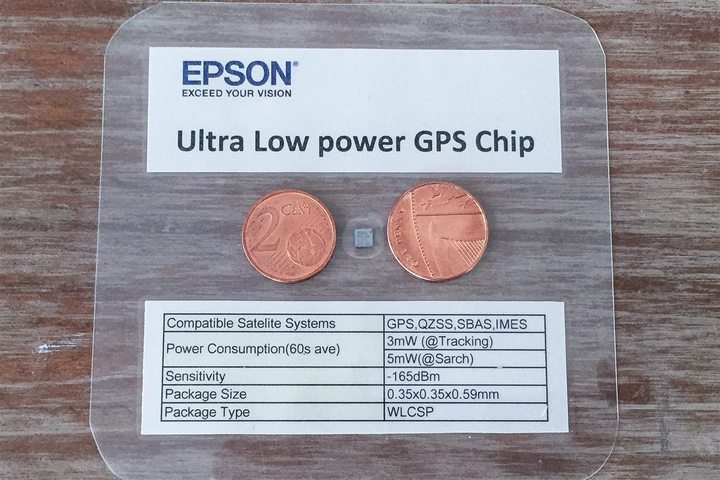
But they have reason to be proud, they’ve done fantastically well there. It is as good or better than any unit I’ve seen in the various conditions I’ve run in (cities, forests, deserts).

I haven’t seen it cut corners, with it snapping near perfectly to where I’ve run:

Over and over again it proves itself. Even when other watches were ‘good’, the SF-180 tended to be just a little bit better (data shown using MyGPSFiles tool), such as below in one minor turn around a building the Epson plotted a slightly more accurate track there.

Here’s a rundown of various run distances over the last few months, with a few different distances where I had multiple units on:
Epson GPS Accuracy
18-MarParis City Run5.625.6315-MarLong Run10.2610.3212-MarBahrain Dessert4.124.158-MarHalf-Marathon13.1313.0417-FebEvening Run7.817.7714-FebLong Run14.5314.4310-FebTreadmill5.045.805-FebTreadmill6.266.461-FebCycling Ride30.0630.1026-DecNewfoundland5.675.6818-DecNew York City7.207.177-DecLondon Downtown11.8812.1023-NovCity & Park Run8.048.0416-NovCity River Run11.1111.1313-NovInterval Run8.558.6510-NovCity Interval Run7.127.148-NovCity River Run10.0210.06
Overall I’m just not seeing issues with GPS accuracy with the unit. Simple as that.
Mobile Phone App:
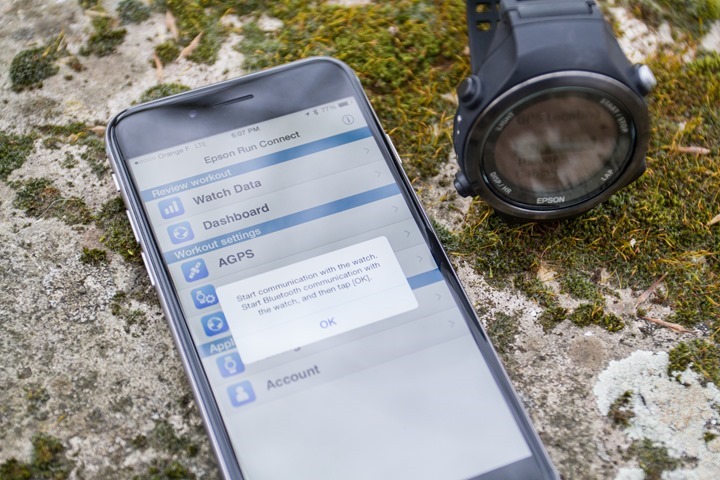
The Epson lineup connects to the Epson Run Connect app on your mobile phone. This app is available for iOS and Android. The app is a bit…rough. But it mostly gets the job done, even if it’s slow and ugly.
To start, you’ll crack open the app on your mobile phone and sign-in with your Runsense website credentials, this will enable uploading of activities. Then, on the watch you’ll hold down the light button to get into the menu to start the connection over Bluetooth Smart.
Once that’s done the watch is basically in waiting mode and will receive connections from the app.
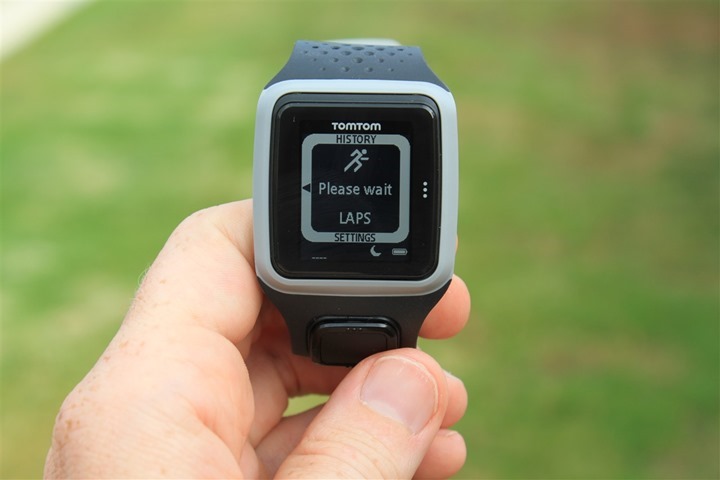
The app will perform basic tasks like downloading and transferring data to the website. The only challenge here is that a simple 40 minute run takes 3-4 minutes to transfer. That’s approximately forever. A typical 40-minute run on a Garmin, Polar, or Suunto device to transfer over Bluetooth Smart usually takes under 30 seconds.
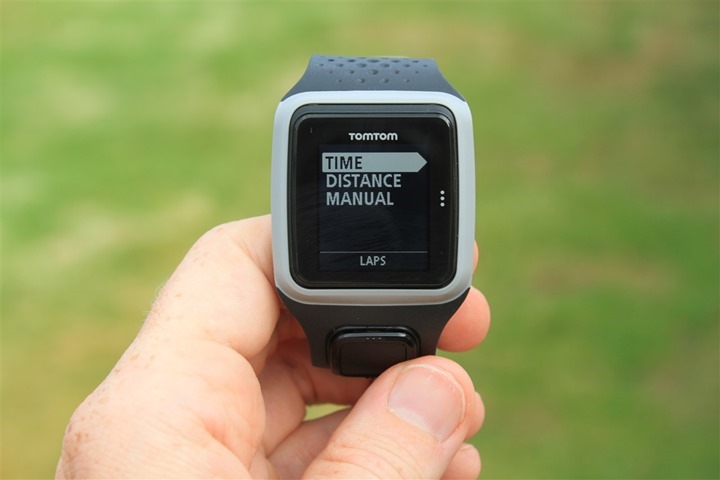
The trick is that the mobile app is basically critical to changing many of the settings. For example, it’s here that you can change the watch display settings:
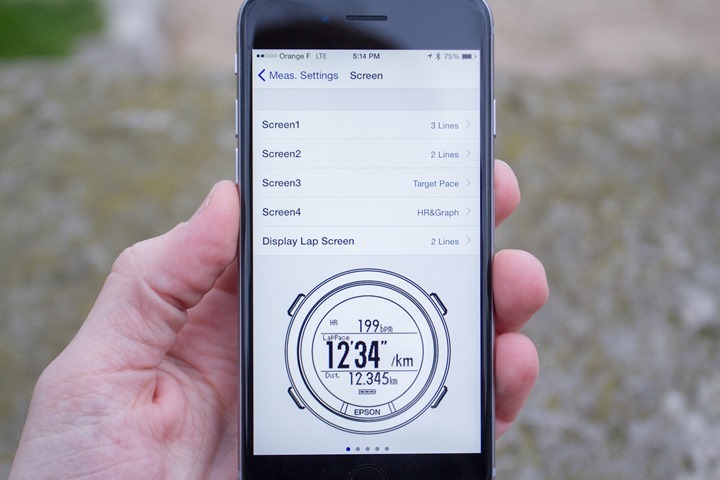
And it’s also here that you can configure aspects like automatic lap, backlight settings, as well as intervals and pace.
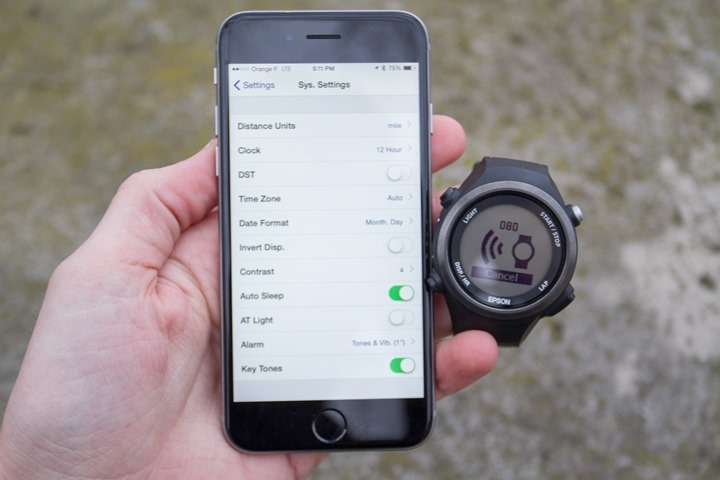
And finally, it’s here that you can update the GPS cache…which as I noted earlier is only good for two hours. Why can’t this data be cached for a longer timer period, and why doesn’t it just happen automatically anytime the app is opened?
Unfortunately, like you’ll see with the website, the mobile app just lacks clean user interface flow. While the data field display selection screen is actually pretty cool and well executed, the rest of it is really behind the curve. It’s generally slow (even on an iPhone 6), and very modal, with almost every interaction requiring waiting on the watch for the next move.
Desktop App:
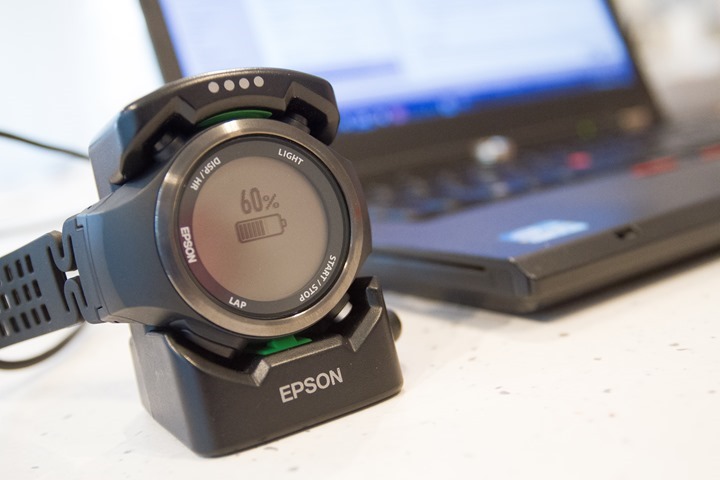
In addition to using the mobile app to upload your runs or tweak settings, you can use the Epson Run Connect desktop application. This application is much like applications from other watch companies in that it serves as a conduit from the watch to the website.
You’ll go ahead and configure it with your Epson Runsense credentials, which will then upload runs from the watch to the training log website each time:

You can select which activities to upload, if you’d like – potentially throwing away junk ones like the short little test ones you see up top.


In addition to that, you can use the Run Connect application to make minor settings changes within the watch. For example you can change the target pace, automatic lap, and the units.


What you see above though is kinda the entirety of the configuration options from the desktop app. It’s too bad, as it seems a bit half-hearted. Still, I suppose it’s better than some watches that offer no options.
The Website:
Once you’ve uploaded your activities via either USB or Bluetooth Smart, it’s time to view them on the Epson website – Runsense. That’s the consolidated training log site that all activities end up on.

To start, from the dashboard you can get a monthly view of your activities:

You can then click on a given activity to get a deeper view into it:


And more information if you expand out the summary section:

And, if you click the map expandy thing, you can see your route track:

Through a multi-step process, you can also share out a workout link as well. Here’s one you can open and look at if you’d like.

Like other tracking sites, it does include the ability to look at time graphs of runs and some basic analysis. I’ve created a small gallery of screenshots here to show some of the functionality:
Of course, I suspect by this point you’re already seeing the problem. But I’ll be super nice about it: The website is horrible. Really, it is. They developed it internally, and its user interface, responsiveness, and just general usability is reminiscent of AOL in 1995 (floppy disk edition).
I rarely advise sports tech companies to outsource their websites to other fitness companies, because that often limits their ability to innovate within the online fitness space. Plus, these days the data side is virtually just as valuable. But in this case – I’m begging you Epson – please outsource the site to someone who can really take things to a better level.
3rd Party App Support:
Epson supports exporting from the Runsense site in two file formats, as well as direct sync. These two file formats are:
– Export of .CSV files (contains GPS location, time, lap information, and heart rate)
– Export of .GPX files (contains GPS location, time, and heart rate)
You can export any given file from the menu along the top of that activity file:

The challenge with both of those file formats is that while many developers think of them as ‘ideal’, they actually aren’t ideal for fitness. That’s because app developers all use those file formats slightly differently. For example, when I try and import the .GPX file to Strava, it doesn’t know what to do with the HR data (so it doesn’t show up).
On the bright side, Epson has partnered with Tapiriik, which is fast becoming the single best resource for activity/fitness data file sync within the industry. I wrote up a piece on it a year ago here. It basically syncs to any number of platforms for you automatically.

You can then connect to the Epson Runsense service there:

From there you can configure how, where and what syncs to and from Epson’s service:

So while Epson’s immediate export capabilities leave a bit on the table, their support and encouragement in using Tapiriik should certainly be applauded. I only wish other platforms made it easier for Tapiriik to get the raw/original data files (i.e. Garmin, which doesn’t send the .FIT files but rather the reduced .TCX files).
Finally, Epson notes that almost any day now you should see Strava show up as well with having direct sync from Epson Runsense to Strava.
FAQ’s/Things That Didn’t Fit:
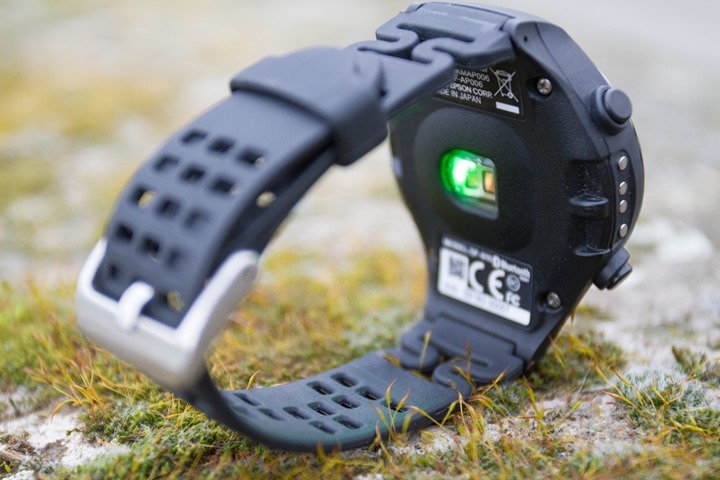
I typically write reviews in chunks on given topics (i.e. smartphone integration, running, etc…). In the case of the Epson unit, there’s less of these big-chunks within the review to group details into. So in that case, I’m making them a bit of an FAQ section for topic areas I suspect there will be questions on, but that didn’t otherwise fit.
Does the SF-810 connect to any sensors?
No, not at this time. Neither ANT+ or Bluetooth Smart, for any sensor types. Some of the other Runsense models though can connect to a Bluetooth Smart heart rate sensor.
Does the SF-810 track daily steps and distance walked (activity tracker)?
No, it does not. The Pulsesense lineup does however.
Will the SF-810 track my pulse throughout the day?
Yes and no. It’ll track it if you switch into that mode (just tap the DISP/HR button), but it won’t save or record it anywhere. So it’s just to look at.
Does the SF-810 have smartwatch features like smartphone notifications?
No, it does not. It can connect to your smartphone for uploading workouts and configuring watch settings, but it does not sustain that connection for things like phone notifications or live tracking.
I saw that Meb Keflezighi is running with Epson now instead of Garmin, thoughts?
My thoughts here are roughly the same as for any athlete: Money always talks. I say this be it an athlete sponsored by Garmin, Polar, SRM, or Nike. And, any honest professional athlete will also note the same. Meb is a great runner, and as a great professional athlete you have to take on sponsors.
Which doesn’t mean I don’t think these companies make good products (they do), but simply that a professional athlete like Meb will go where the money is. When someone offers him substantially more, he’s going to follow the funds. For low-money sports like triathlon and running, you have to.
Is it waterproof?
Yes, the unit is waterproofed to 50m. I’ll hit my waterproofing test chamber shortly, as part of a large waterproofing chamber ‘field day’ that I’ll do with a number of watches (Fenix3, Ambit3 Run, Vivoactive, etc…).
Will the SF-810 track my pulse and GPS track while swimming?
I’ve tried this in only one swim (openwater). In that instance, it did not track GPS very well, nor did it track HR very well:

Again, this was for an openwater swim, and not a pool swim. I did not swim with it during a pool swim, and there’s no functionality for it to track lap distances within a pool (or openwater for that matter).
What about battery life?
I’m really impressed here. I rarely charged the unit – and it always seemed to be happy to go for a run. Only once did it die mid-run on me, and that was a case where I suspected it was going to do that. Officially the unit gets up to 20 hours of GPS-on/optical HR-on battery life, or up to 24 hours with GPS on but optical HR off.
Product Comparison Tool:
I’ve added the Epson SF-810 into the product comparison tool, this means you can mix and match it against any unit I’ve reviewed on the site to date. For the purposes of comparison in this post, I’ve matched it against the TomTom Cardio Runner and the Fitbit Surge, which seem to be in the same range for price and functionality – though it’s a bit tricky as there’s only partial overlap in certain areas.
But remember you can create your own comparison chart here through the product comparison tool.
Copyright DC Rainmaker – Updated November 28th, 2016 @ 8:29 amNew Window
Price$349$269.00$249
Product Announcement DateAugust 2014Apr 2, 2014Oct 27th, 2014
Actual Availability/Shipping DateFall 2014 to Spring 2015Mid-April 2014Dec 10th, 2014
GPS Recording FunctionalityYesYesYes
Data TransferUSB/Bluetooth SmatUSB/Bluetooth SmartBluetooth Smart
Waterproofing50 metersATM5 (~50m)ATM5 (~50m), but no swimming
Battery Life (GPS)20hrs10hrs with GPS-on10 hours GPS on (5-7 days in time/step mode)
Recording Interval1-second1-second1-second
Satellite Pre-Loading via ComputerYesYesNo
Quick Satellite ReceptionDependsExcellentSo-so
AlertsVIBRATE/SOUND/VISUALAudio/Visual/VibrateYes
Backlight GreatnessGreatGreatGood
Ability to download custom apps to unit/deviceNoNoNo
Acts as daily activity monitor (steps, etc…)NoNoYes
Can control phone musicNo
Has music storage and playbackNo
Bluetooth Legacy (pre-4.0) to PhoneNoNoNo
Bluetooth Smart (4.0+) to Phone UploadingYEsYesYes
Phone Notifications to unit (i.e. texts/calls/etc…)NoNoText and Call notifications only
Live Tracking (streaming location to website)NoNoNo
Group trackingNo
Emergency/SOS Message Notification (from watch to contacts)NoNoNo
Built-in cellular chip (no phone required)NoNoNo
Designed for cyclingNoNoYes
Speed/Cadence Sensor CapableNoN/AN/A
Strava segments live on deviceNoNoNo
Crash detectionNo
Designed for runningYesYesYes
Footpod Capable (For treadmills)No (has built-in accelerometers)No, has internal accelerometerNO, HAS INTERNAL ACCELEROMETER
Running Dynamics (vertical oscillation, ground contact time, etc…)NoNoNo
VO2Max EstimationNoNoNo
Race PredictorNoNoNo
Recovery AdvisorNoNoNo
Run/Walk ModeNoNoNo
Designed for swimmingNo (protected though just fine)No (protected though just fine)No
Record HR underwaterNot wellN/AN/A
Designed for triathlonNoNoNo
Multisport modeNoNoNo
Create/Follow custom workoutsNoNoNo
On-unit interval FeatureYesYesNo
Training Calendar FunctionalityNoNoNo
Auto Start/StopYesNoNo
Virtual Partner FeatureYesYesNo
Virtual Racer FeatureNoYesNo
Records PR’s – Personal Records (diff than history)NoNoNo
Day to day watch abilityYesYesYes
Hunting/Fishing/Ocean DataNoNoNo
Tidal Tables (Tide Information)NoNoNo
Jumpmaster mode (Parachuting)NoNoNo
GeocachingNoNoNo
Weather Display (live data)NoNoNo
Follow GPS Track (Courses/Waypoints)NoNoNo
Markers/Waypoint DirectionNoNoNo
Routable/Visual Maps (like car GPS)NoNoNo
Back to startNoNoNo
Impromptu Round Trip Route CreationNoNoNo
Download courses/routes from phone to unitNoNoNo
Altimeter TypeBarometricGPSBarometric
Optical Heart Rate Sensor internallyYesYesYES
Heart Rate Strap CompatibleOptical HR sensor in unitYes (also internal optical HR sensor)Contains optical HR SENSOR
ANT+ Heart Rate Strap CapableNoNoNo
ANT+ Speed/Cadence CapableNoNoNo
ANT+ Footpod CapableNoNo, has internal accelerometerNo
ANT+ Power Meter CapableNoNoNo
ANT+ Weight Scale CapableNoNoNo
ANT+ Fitness Equipment (Gym)NoNoNo
ANT+ Lighting ControlNoNoNo
ANT+ Bike Radar IntegrationNoNoNo
ANT+ Trainer Control (FE-C)NoNoNo
ANT+ Remote ControlNoNoNo
ANT+ eBike CompatibilityNoNoNo
ANT+ Muscle Oxygen (i.e. Moxy/BSX)No
ANT+ Gear Shifting (i.e. SRAM ETAP)No
Shimano Di2 ShiftingNoNoNo
Bluetooth Smart HR Strap CapableNoYes (also internal optical HR sensor)No
Bluetooth Smart Speed/Cadence CapableNoNoNo
Bluetooth Smart Footpod CapableNoNoNo
Bluetooth Smart Power Meter CapableNoNoNo
Temp Recording (internal sensor)YesNoNo
Temp Recording (external sensor)NoNoNo
Compatible with Firstbeat HR toolsNoNoNo
PC ApplicationWindows/MacMySports ConnectWindows/Mac
Web ApplicationYesTomTom MySportsYes
Phone AppiOS/AndroidiOS/AndroidiOS/Android/Windows Phone
Ability to Export SettingsNoNoNo
Amazon LinkLinkLinkLink
Clever Training Link (Save 10% with DCR10BTF)N/ALinkLink
Clever Training Europe (Save 10% with DCR10BTF)Link
Review LinkLinkLinkLink
And again, remember that you can create your own comparison chart here through the product comparison tool.
Summary:
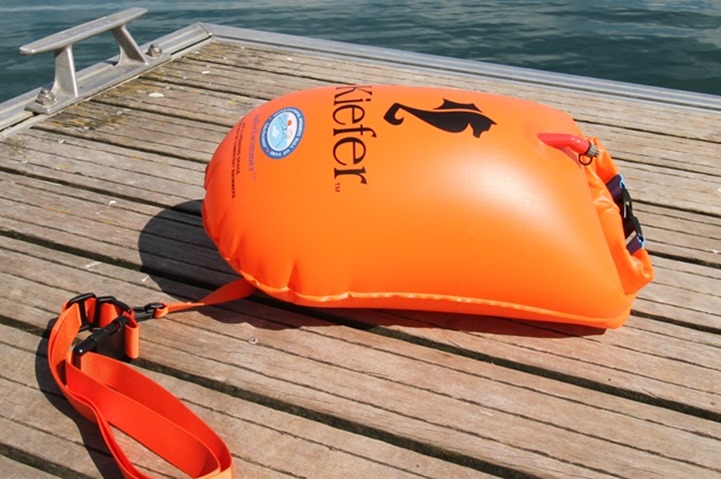
The Epson SF-810 is a bit of an interesting duck in the GPS running watch landscape. It’s got unique features that very few other watches have – such as optical heart rate monitoring that’s actually largely accurate. It also has solid GPS accuracy and good battery life. Similarly, it has good customize options for the data pages and fields – albeit only with the mobile phone app.
The challenge though with the SF-810 isn’t that it gets the basics right and messes up elsewhere. It’s that it only has the basics. Which wouldn’t be a problem if we were talking a $100-$200 GPS watch ($200 for the optical side). But in this case, we’re talking a $350 GPS watch. That means it’s competing against units between $250 and $400, since that’s the price range that most competitive units fall into. The tough part is that even when Epson has some of these features, they’re often cumbersome to use and find within the watch (or apps). There’s very little that’s truly intuitive about the menu system compared to Suunto/Polar/Garmin, and many other watches on the market. About the only watch I can think of that’s less intuitive to use is some of the Soleus lineup.
On the bright side, if you aren’t looking for lots of advanced features or don’t care as much about the web/mobile app experiences, the watch itself does get the core functions down and does them well…once you get the hang of it.
So my recommendation here is mixed. I think Epson has a really good base to work from, but they need to simplify their offerings (just do two watches), revamp their website and mobile apps, and then focus on merging the Runsense and Pulsense lineups, such that it can compete with today’s GPS watches that do contain activity trackers. And finally, they need to stop trying to release slightly separate products and timelines in separate countries. The watches launched in Japan last summer, then Europe this fall and winter, and the US this spring. When was the last time you saw Polar, Garmin, Suunto, Timex, or anyone else of size do that? Never – it confuses the heck out of consumers and fragments interest. If a consumer can’t buy a watch when they first hear about it, they’ll forget about it and move on.
If they can make those minor changes to the platform, they might have a really interesting competitor for the holiday season at the end of the year. As I noted, they certainly have a good foundation to work from.
Thanks for reading, and feel free to drop any questions below!

